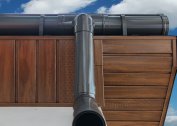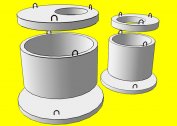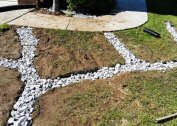Some owners of private houses, making it difficult to equip a septic tank, are limited to digging a hole and draining its bottom. Water goes into the ground, and all substances settle to the bottom. When the pit stops working properly, they dig a new one. There are several reasons for filling up a drive.
The main causes of the problem
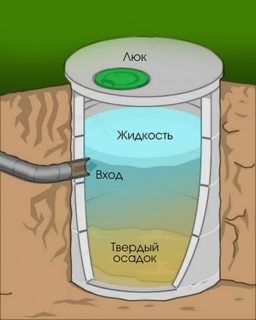 If the water from the pit does not leave even after frequent pumping of the contents, this may be due to:
If the water from the pit does not leave even after frequent pumping of the contents, this may be due to:
- The porous part of the soil is clogged with fat.
- A thick organic mud layer was formed, which sank to the bottom and does not allow water to pass through.
- Leaves or other extraneous debris got into the pit.
- Groundwater level increased.
- Added sources of wastewater (additional plumbing fixtures).
- Incorrect calculation of the volume of sewage or natural water flow.
- In winter, the ground freezes and does not absorb liquid.
Methods to Eliminate Bad Outflow
According to the law of communicating vessels, the levels of homogeneous liquids (if counted from the closest point on the surface) must be the same. If we take the cesspool as one vessel, and the hygroscopic soil layer around it as the second, then we must take into account the ability of the second “vessel” to absorb liquid. That is, the filling rate of the pit should be synchronous with the absorption rate. To do this, it is enough to reduce the amount of incoming water (reduce the stream when washing dishes, washing, and so on).
In addition to this method of preventing overflow of the cesspool, there are several more important and effective:
- Provide all cranes with grease catchers.
- To equip a septic tank (you can dig a new hole next to the old one, connecting them to get communicating vessels).
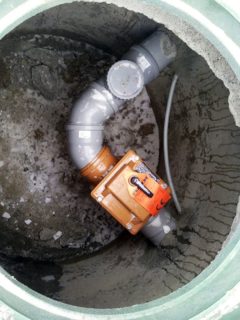 If the pit is filled by two-thirds - this is a signal to take measures to clean the bottom and walls. There are several options:
If the pit is filled by two-thirds - this is a signal to take measures to clean the bottom and walls. There are several options:
- Clean yourself with a bucket or fecal sucker. To do this, you should invite an assistant, stock up on protective clothing, protect your eyes, respiratory tract and skin from toxic fumes and substances. Order a suction pump, provided the depth of the pit is not more than 3 meters.
- Pump out water, use bacteria to soften and reduce the amount of sludge. Brush to clean the bottom and walls of the pit.
- Clean the grease of the sewer pipe. Rinse again with hot water.
- Replace the filter by laying a 40-centimeter layer of gravel or crushed stone and sand at the bottom.
- To destroy the crust of organic matter at the bottom of the pit, a biological product is used (Vodograi and Alligator), which treat wastewater. But as a result, the water will drop only by 10-50 cm. If pumping out much more, the pressure of the liquid in the pit will drop, and it will again be filled with water from the soil (according to the law of communicating vessels). In addition, expensive bacteria disappearing into the pit and not yet starting work will disappear.
To use such drugs as much as possible, they need to create the conditions:
- The thickness of the water covering the waste should not exceed 5 cm (otherwise the process will slow down very much.) But then the equilibrium of the liquid columns in the pit and hygroscopic soil is disturbed.
- Plus temperature (otherwise the bacteria are inactive).
- Refuse during the cleaning of the pit from the "killers" of bacteria: chlorine, manganese, antibacterial substances that are in detergents.
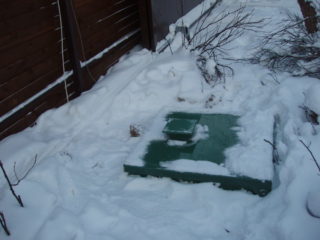 In winter, defrost is used to restore the function of the cesspool. Hot water cannot help, in such cases a specialist is needed who does not violate the laws of electricity. If the owner decides to defrost himself, his actions are as follows:
In winter, defrost is used to restore the function of the cesspool. Hot water cannot help, in such cases a specialist is needed who does not violate the laws of electricity. If the owner decides to defrost himself, his actions are as follows:
- Prepare a copper wire passing 2 kW, a small hook, a metal pin 20 cm long, wear rubber boots and gloves.
- Remove from the area of action of strangers, animals and containers with liquids.
- Drive the pin into the center of the pit.
- Strip the end of the wire and connect to the rod in the pit.
- Using a hook, connect the other end of the wire to electricity.
- Defrost for two days.
They also use blowtorches or make bonfires, but this is long and unpleasant. If plastic sewage pipes are frozen, it is necessary to call specialists who will quickly and without risk defrost the entire system along with the pit.
Preventive measures to prevent problems
 To prevent overfilling of the pit and prolonging the service life, preventive measures must be taken. These include:
To prevent overfilling of the pit and prolonging the service life, preventive measures must be taken. These include:
- The use of chemicals for the rapid breakdown of solid accumulations. When choosing them, consideration should be given to their environmental impact. The cheapest, but also the most dangerous, is formaldehyde. The drug with nitrate is expensive, but the product of its action is applicable as a fertilizer. In addition, this drug neutralizes odors.
- The use (once a month) of bacteria-containing preparations in the warm season.
- Periodic and timely pumping of waste. To do this, you can install an automatic pump that does not require the presence of a person.
- Regular (every 6-8 weeks) flushing the entire system with water under pressure.
- Warming and continuous use of the pit in winter for regular heating.
- The main condition for the functioning of the cesspool is the correct calculation when laying the entire sewer system and conducting a geological examination to establish the depth of the water.
- Water drainage to the filtration field. It is carried out both at the initial stage of the device, and during operation. To do this, next to the pit, excavate the soil one and a half meters down, make a pillow of agrofibre and gravel, lay a perforated pipe on it to drain the liquid. It is covered with gravel, then agrofibre.
Conclusion
Even such a simple sewage device as a cesspool requires proper calculation when it is equipped and good care. To reduce the cost of maintenance equipment, two-thirds of the contents of the pit should fit in the suction pump. This should be considered when laying the last sewer link. Pumping out is cheaper than buying chemicals, but their use is not associated with dirt and unpleasant odors. In addition, the life of the pit increases.
